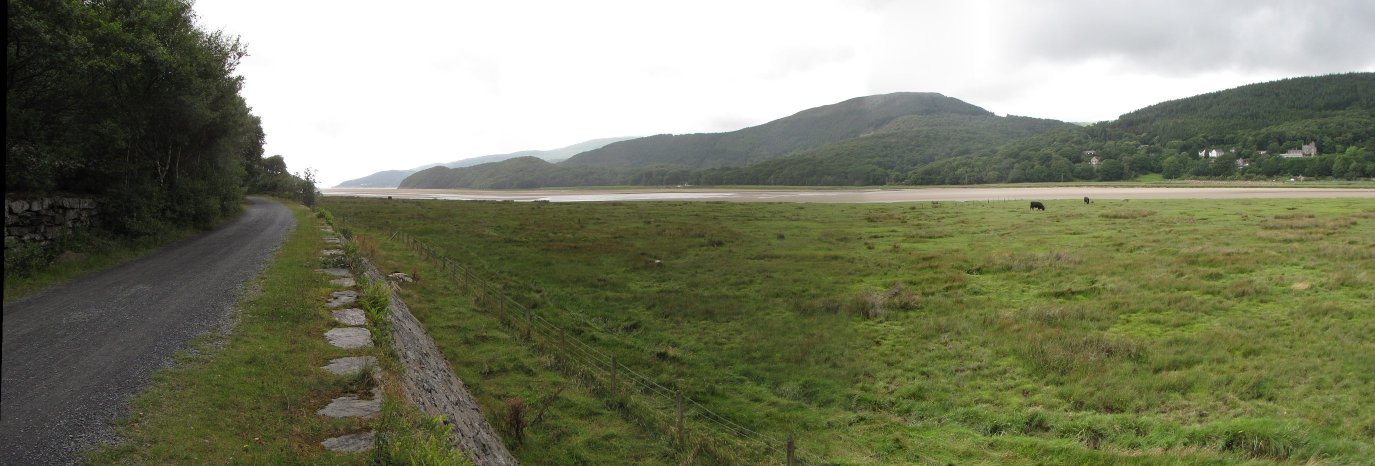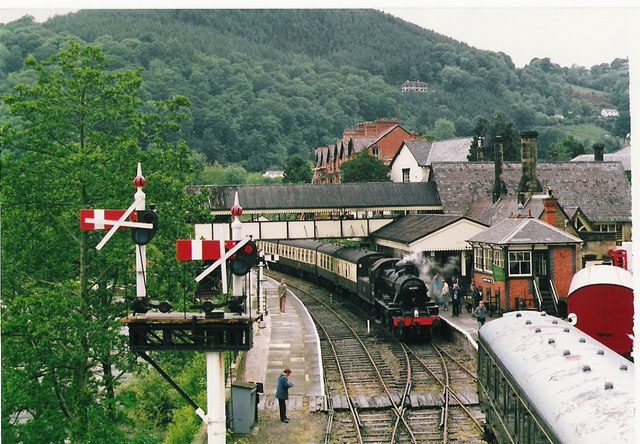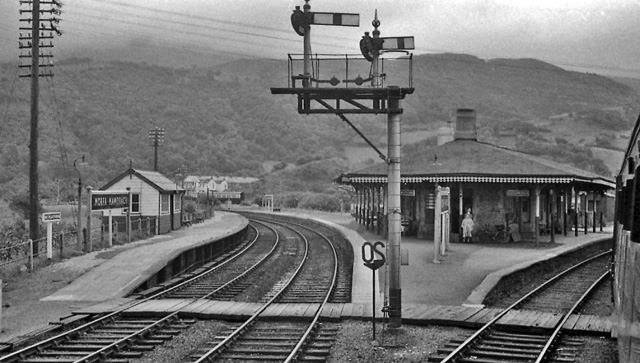|
Ruabon–Barmouth Line
The Ruabon–Barmouth line was a standard-gauge line owned by the Great Western Railway across the north of Wales which connected Ruabon, in the east, with Barmouth on the west coast. History The line opened in stages by various companies: * Vale of Llangollen Railway – 1 December 1861 (goods); 2 June 1862 (passenger) * Llangollen and Corwen Railway – 1 May 1865. This section of the line had gained royal assent in 1860. * Corwen and Bala Railway – 16 July 1866 (Corwen to Llandrillo); 1 April 1868 (Llandrillo to Bala). * Bala and Dolgelly Railway – 4 August 1868. * Aberystwith and Welsh Coast Railway – 10 October 1867 The Aberystwith and Welsh Coast Railway was absorbed by the Cambrian Railways which, with the other companies, was absorbed into the GWR. The line was double track from Ruabon (Llangollen Junction) to Llangollen Goods Yard. From there it was single line with passing loops at the following stations: Deeside Halt, , , , , , , , , , , and . Connections ... [...More Info...] [...Related Items...] OR: [Wikipedia] [Google] [Baidu] |
Standard-gauge
A standard-gauge railway is a railway with a track gauge of . The standard gauge is also called Stephenson gauge (after George Stephenson), international gauge, UIC gauge, uniform gauge, normal gauge in Europe, and SGR in East Africa. It is the most widely used track gauge around the world, with about 55% of the lines in the world using it. All high-speed rail lines use standard gauge except those in Russia, Finland, Uzbekistan, and some line sections in Spain. The distance between the inside edges of the heads of the rails is defined to be 1,435 mm except in the United States, Canada, and on some heritage British lines, where it is defined in U.S. customary/ British Imperial units as exactly "four feet eight and one half inches", which is equivalent to 1,435.1mm. History As railways developed and expanded, one of the key issues was the track gauge (the distance, or width, between the inner sides of the rail heads) to be used, as the wheels of the rolling stock (locomoti ... [...More Info...] [...Related Items...] OR: [Wikipedia] [Google] [Baidu] |
Corwen Railway Station
Corwen is a town and community in the county of Denbighshire in Wales. Historically, Corwen was part of the county of Merionethshire. Corwen stands on the banks of the River Dee beneath the Berwyn mountains. The town is situated west of Llangollen and south of Ruthin. At the 2011 Census, Corwen (community and ward) had a population of 2,325, decreasing slightly from the 2001 population of 2,398, The community, with an area of , includes Corwen and the surrounding villages of Carrog, Clawdd Poncen and Glyndyfrdwy. The Office for National Statistics identifies Corwen Built-up area with a 2011 population of 477 and an area of . History Corwen is best known for its connections with Owain Glyndŵr, who was proclaimed Prince of Wales on 16 September 1400, from his nearby manor of Glyndyfrdwy, which began his fourteen-year rebellion against English rule. A statue of Glyndŵr by the sculptor Simon van de Put was installed in The Square in Corwen in 1995, and in 2007 it was re ... [...More Info...] [...Related Items...] OR: [Wikipedia] [Google] [Baidu] |
Dolgellau
Dolgellau (; ) is a town and Community (Wales), community in Gwynedd, north-west Wales, lying on the River Wnion, a tributary of the River Mawddach. It was the traditional county town of the Historic counties of Wales, historic county of Merionethshire until the county of Gwynedd was created in 1974. Dolgellau is the main base for climbers of Cadair Idris and Mynydd Moel which are visible from the town. Dolgellau is the second largest settlement in southern Gwynedd after Tywyn and includes the community of Penmaenpool. Etymology The name ''Dolgellau'' is a compound of 'water-meadow' and , the plural of 'a cell', giving the meaning 'water-meadow of cells'. The in the name was probably located within a bend at the confluence of the rivers Wnion and Aran. The may refer to monastic cells or merchant's stalls. The earliest recorded spelling (from 1254) is ''Dolkelew'', and a spelling ''Dolgethleu'' dates from 1294–5 (the ''thl'' is an attempt to represent Welsh ). Owain Glynd� ... [...More Info...] [...Related Items...] OR: [Wikipedia] [Google] [Baidu] |
Rail Trail
A rail trail or railway walk is a shared-use path on a Right of way#Rail right of way, railway right of way. Rail trails are typically constructed after a railway has been abandoned and the track has been removed but may also share the rail corridor with active railways, light rail, or tram, streetcars (rails with trails), or with disused track. As shared-use paths, rail trails are primarily for non-motorized traffic including pedestrians, bicycles, horseback riders, skaters, and cross-country skiers, although snowmobiles and all-terrain vehicle, ATVs may be allowed. The characteristics of abandoned railways—gentle grades, well-engineered rights of way and structures (bridges and tunnels), and passage through historical areas—lend themselves to rail trails and account for their popularity. Many rail trails are long-distance trails, while some shorter rail trails are known as Greenway (landscape), greenways or linear parks. Rail trails around the world Americas Bermuda The B ... [...More Info...] [...Related Items...] OR: [Wikipedia] [Google] [Baidu] |
Mawddach Trail
The Mawddach Trail () is a cycle path route, part of Lôn Las Cymru, which runs for some from Dolgellau to Morfa Mawddach railway station , by Barmouth bridge on the Cambrian coast. It is maintained by the Snowdonia National Park and is popular with hillwalking, walkers and cyclists alike. It passes some estuarine areas that are important for water birds, and the RSPB Information Centre at Penmaenpool makes use of the old signal box as an observation centre overlooking the estuary. The cycle route is a rail trail running along the former trackbed of the Ruabon Barmouth Line, Ruabon to Barmouth branch line of the Great Western Railway. This line closed under the Beeching Axe in the 1960s. External linksGwynedd Council - Recreational Routes - Mawddach Trail [...More Info...] [...Related Items...] OR: [Wikipedia] [Google] [Baidu] |
Llangollen Railway
The Llangollen Railway () is a volunteer-run heritage railway in Denbighshire, North Wales, which operates between Llangollen and Corwen. The standard gauge line, which is long, runs on part of the former Ruabon Barmouth Line, Ruabon – Barmouth Great Western Railway, GWR route that closed in 1965. It operates daily services in the summer as well as weekends throughout the winter months, using a variety of mainly ex-GWR steam locomotives as well as several diesel engines and diesel multiple units. A extension of the railway has been built to complete the line to Corwen. In March 2021, the railway company announced that, having made a loss in three consecutive years, they had invited their bank to appoint receivers. Operation of the railway was handed over to the Llangollen Railway Trust, and the line reopened July 2021. History Commercial service: 1865–1962 Llangollen was already a popular place for tourists by the 1840s. Travel up to this time had been by horse-drawn ca ... [...More Info...] [...Related Items...] OR: [Wikipedia] [Google] [Baidu] |
Bala Lake Railway
The Bala Lake Railway ( Welsh: ''Rheilffordd Llyn Tegid'') is a narrow-gauge railway along the southern shore of Bala Lake in Gwynedd, North Wales. The line, which is long, is built on a section of the former standard-gauge Ruabon–Barmouth GWR route that closed in 1965. Another section of the former permanent way is used by the Llangollen Railway. The Bala Lake Railway, which runs on -gauge preserved rolling stock, is a member of the Great Little Trains of Wales. The railway now has the largest collection of historic narrow-gauge quarry locomotives built specifically for the Slate industry in Wales, slate industry in North Wales by the Hunslet Engine Company in Leeds. History Standard Gauge The narrow-gauge Bala Lake railway uses the permanent way of the former standard-gauge A standard-gauge railway is a railway with a track gauge of . The standard gauge is also called Stephenson gauge (after George Stephenson), international gauge, UIC gauge, uniform gauge, norm ... [...More Info...] [...Related Items...] OR: [Wikipedia] [Google] [Baidu] |
Heritage Railway
A heritage railway or heritage railroad (U.S. usage) is a railway operated as living history to re-create or preserve railway scenes of the past. Heritage railways are often old railway lines preserved in a state depicting a period (or periods) in the history of rail transport. Definition The British Office of Rail and Road defines heritage railways as follows:...'lines of local interest', museum railways or tourist railways that have retained or assumed the character and appearance and operating practices of railways of former times. Several lines that operate in isolation provide genuine transport facilities, providing community links. Most lines constitute tourist or educational attractions in their own right. Much of the rolling stock and other equipment used on these systems is original and is of historic value in its own right. Many systems aim to replicate both the look and operating practices of historic former railways companies. Infrastructure Heritage railway li ... [...More Info...] [...Related Items...] OR: [Wikipedia] [Google] [Baidu] |
Beeching Axe
The Beeching cuts, also colloquially referred to as the Beeching Axe, were a major series of route closures and service changes made as part of the restructuring of the nationalised railway system in Great Britain in the 1960s. They are named for Dr. Richard Beeching, then-chair of the British Railways Board and the author of two reports''The Reshaping of British Railways'' (1963) and ''The Development of the Major Railway Trunk Routes'' (1965) that set out proposals for restructuring the railway network, with the stated aim of improving economic efficiency. The first report identified 2,363 stations and of railway line for closure, amounting to 55% of stations, 30% of route miles, and the loss of 67,700 British Rail jobs, with an objective of stemming the large losses being incurred during a period of increasing competition from road transport and reducing the rail subsidies necessary to keep the network running. The second report identified a small number of major routes f ... [...More Info...] [...Related Items...] OR: [Wikipedia] [Google] [Baidu] |
Cambrian Coast Line
The Cambrian Line (), sometimes split into the Cambrian Main Line () and Cambrian Coast Line () for its branches, is a railway line that runs from Shrewsbury in England, westwards to Aberystwyth and Pwllheli in Wales. Passenger train services are operated by Transport for Wales between the western terminals of Pwllheli, in Gwynedd, and Aberystwyth, in Ceredigion, and the eastern terminal at Shrewsbury, Shropshire, as part of the Wales & Borders franchise. The railway line is widely regarded as scenic, as it passes through the Cambrian Mountains in central Wales and along the coast of Cardigan Bay in Snowdonia National Park. The line includes long sections of rural single track and is designated as a community rail partnership. Route From Shrewsbury, the line heads west through northern Powys, serving the towns of Welshpool and Newtown, then continues further west calling at Caersws and then Machynlleth until reaching . At Dovey Junction, a short distance west of Machynlleth, ... [...More Info...] [...Related Items...] OR: [Wikipedia] [Google] [Baidu] |
Morfa Mawddach Railway Station
railway station (formerly Barmouth Junction) is an unstaffed station located on the outskirts of the village of Arthog in Gwynedd, Wales, on the Cambrian Line, Cambrian Coast line between and . Built by the Aberystwith and Welsh Coast Railway in 1865, it was formerly the junction station for the Ruabon to Barmouth Line. Since the closure of the Ruabon to Barmouth line in 1965, it remains open, as a minor station on the Cambrian Line. History The station was built by the Aberystwith and Welsh Coast Railway, Aberystwith and Welsh Coast Railway and opened on 3 July 1865 as Barmouth Junction. From 1899 to 1903 there was a connection with the Barmouth Junction and Arthog Tramway. The station was host to a Great Western Railway, GWR camping coach, camp coach from 1934 to 1939. A camping coach was also positioned here by the Western Region of British Railways, Western Region from 1956 to 1962. In 1963 the administration of camping coaches at the station was taken over by the London ... [...More Info...] [...Related Items...] OR: [Wikipedia] [Google] [Baidu] |






